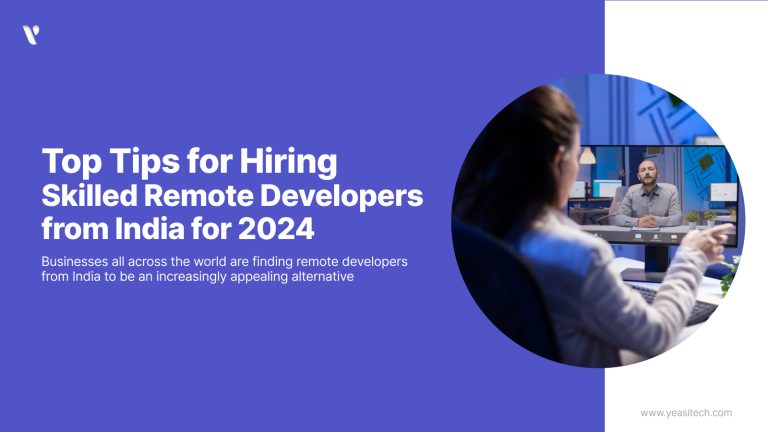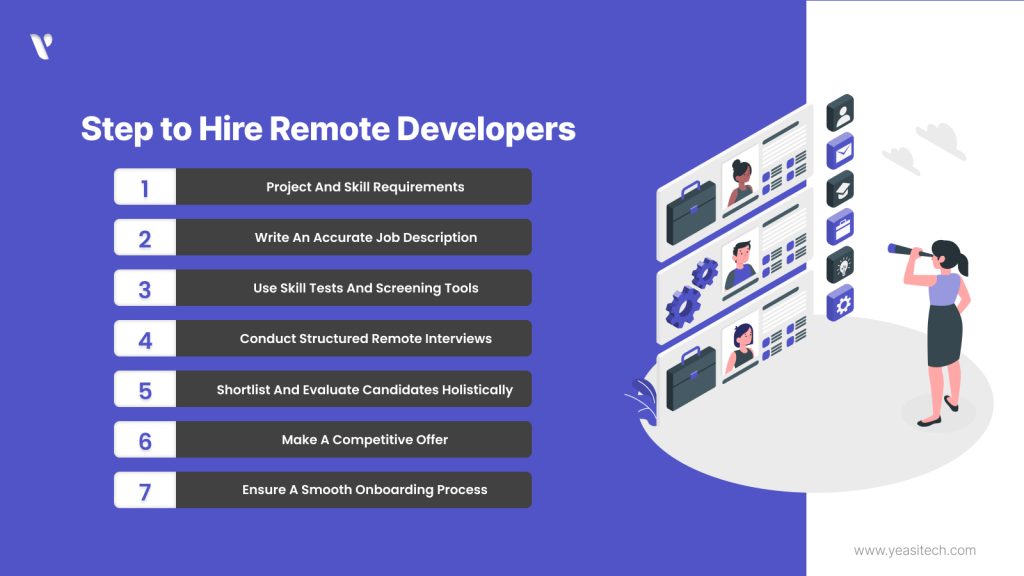Top Tips for Hiring Skilled Remote Developers from India for 2025

Businesses all across the world are finding remote developers from India to be an increasingly appealing alternative. If you’re a business owner, you’re probably wondering how to join in. One important factor in hiring remote developers is the technology and tools they use. It’s also important to consider their availability, communication skills, and ability to work well remotely.
Relax, we are available to assist you. We’ll walk you through the process of hiring a remote developer step-by-step in this post. Continue reading to find out all you need to know about locating, screening, and employing the top remote software developers available.
The IT industry is growing quickly and is in high demand. But this growth comes with a big shortage of skilled developers, leading the IT sector to aim for building teams with the best talent.
Due to strong competition, employers need to rethink how they keep their employees and offer better salaries and regular raises. Right now, start-ups and small businesses struggle to win the talent war because they can’t afford to provide high salaries and benefits while staying profitable.
India has over 3,500 IT institutes that produce more than 1 million engineering graduates every year. This is the largest number ever recorded for engineering education institutions and infrastructure. In recent years, India has become the most popular place for hiring remote developers.
The quick expansion of software and mobile app development has created a great deal of additional work for development businesses throughout the globe. The lack of resources, particularly highly qualified individuals, is a common side effect of this development, though. Recruiting remote software engineers from India makes sense in this scenario.
By using offshore development, companies may narrow the skills gap, employ programmers with in-demand talents, and expand their capabilities and resources. Because of offshore employment, they can reduce the cost of creating IT infrastructure and resource mobilization.

Hiring remote developers from India can be a strategic move for accessing top talent while optimizing costs. Here’s an illustrated guide to help you with the procedure:
Before beginning your search, articulate the project’s scope, goals, and timelines. Identify the essential technical skills, tools, and programming languages required for the role. This clarity will not only guide your hiring process but also ensure you attract the right talent with the appropriate expertise.
A detailed job description is crucial to attracting high-quality candidates. Focus on specifying the key responsibilities, technical requirements, and soft skills needed. Transparency about compensation, benefits, and work expectations—especially regarding remote work structure and flexibility—helps you stand out to the right developers.
To streamline your candidate pool, use technical screening tools to assess skills objectively. Platforms like HackerRank, Codility, or TestDome provide coding assessments that help evaluate candidates’ proficiency in programming, algorithms, and problem-solving. This step ensures that only skilled candidates move to the interview phase, saving time and improving the hiring process’s efficiency.
During remote interviews, focus on both technical abilities and soft skills like communication and teamwork. Consider a mix of technical interviews (live coding challenges) and behavioral interviews. Assess how well candidates can work independently, manage time, and collaborate remotely, as these are critical for remote development roles.
Once interviews are completed, review candidates based on a combination of technical assessments, communication skills, and cultural fit. For remote work, qualities like self-motivation, time management, and accountability should be heavily weighted. Ensure you verify previous experience, especially any remote work or international collaboration.
Once you’ve identified the right candidate, make an offer promptly. Ensure your offer is competitive, considering global market rates and expectations. Be clear about the salary, benefits, work hours, and expectations around remote work, including time zone coordination. Offering remote work perks, like flexible hours or support for home office setups, can strengthen your offer.
A robust onboarding process is crucial for remote hires. Equip your new developer with all the tools they need, such as access to project management platforms, code repositories, and communication channels. Set clear expectations around performance, timelines, and communication. Regular check-ins during the initial weeks help ensure they integrate smoothly into your team.
Before making any judgments, find out how employing remote engineers from India may help your business. Let’s look at each benefit one by one:
Since living costs in India are low, hiring there is very affordable. You also spend less on other expenses like office supplies and building materials. The following explains why hiring remote developers from India is cost-effective:
STEM is highly valued in India, particularly in the engineering sector. The country generates the most number of engineering graduates yearly. That India has such a big number of successful developers is therefore not unexpected. This will make it easier for you to choose a remote software developer who is qualified for your project.
It’s clear that there’s a bias towards English in the job market. Most companies highly value software developers who can communicate well in English. Since English is the most widely spoken language, such biases are common. Companies also need a common language to ensure smooth and effective teamwork.
Working with remote developers from India offers the advantage of a convenient time zone difference. India is about 9.5 hours ahead of the US East Coast and 12.5 hours ahead of the West Coast. This setup is great for 24-hour development and support. You can also use the time zone difference to cover any gaps in collaboration and communication and to schedule meetings for progress updates and feedback.
Hiring remote developers from India can be a smart and budget-friendly option for businesses that need more talent. India has many skilled developers because of their strong focus on STEM education and good English skills. By following a careful hiring and onboarding process, businesses can make the most of this opportunity.
To find and work with the best remote developers, it is important to take into account cultural variations, legal considerations, and technical and communication capabilities. Each stage of the process is important. You can guarantee a fruitful collaboration that promotes the success of your initiatives by devoting time and energy to these factors.
Don’t delay to hire India’s talented developers if you want to take your projects to new heights. Reach out to Yeasitech right now, and together, let’s create something special!
India has many skilled developers in various technologies. Hiring from India is cost-effective and maintains high quality. The country’s strong English skills and experience with international clients make it a good choice.
Find developers with experience in the right technologies, a strong portfolio, and good references. They should be skilled in programming, follow best practices, and solve problems well. Good communication and time management are important too.
Do thorough reference checks, review portfolios, and hold technical interviews when screening. Start with a small project or trial period to see how they perform before making a long-term commitment.
Effective communication is key. Use project management tools, set clear expectations, and have regular check-ins. Make sure everyone understands the goals and deadlines. Foster collaboration, even remotely.
Build a strong relationship by staying in touch, offering useful feedback, and recognizing their work. Understand their work culture and appreciate their efforts.
Use trusted job sites, tech communities, and agencies that focus on Indian talent. Seek developers with strong credentials, verified reviews, and a good industry track record.
Common challenges include communication problems and time zone differences. To address these, establish clear communication channels, use collaboration tools, and hold regular meetings. Building trust and being transparent also help.
YeasiTech is a trusted IT service partner with 8+ years of experience, empowering 250+ businesses with scalable web, mobile and AI solutions.
Explore related topics to broaden your understanding and gain actionable insights that can transform your strategies.